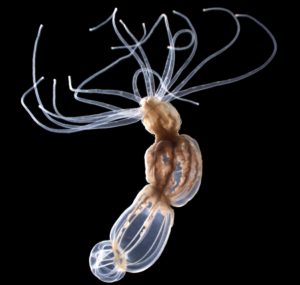By Keiko Weir
Most ocean swimmers are aware, either through warnings from others or firsthand experience, of the painful, itching and burning sensation that can come from an encounter with a jellyfish. The culprit of this unfortunate encounter is a specialized cell called nematocyte. Nematocytes are single-use cells that, under the appropriate environmental cues, explosively eject a venom-coated barb to pierce unsuspecting prey. Jellyfish, sea anemones, and all animals in the phylum Cnidaria, use tentacles covered in nematocytes to capture prey and to defend themselves from predators.

Sea anemone (Nematostella vectensis)
Courtesy of Bellono Lab.
We set out to understand how single nematocytes detect and filter diverse cues from their environment to control when (and when not) to sting. Nematocytes are one-time use cells, and so using them is energetically expensive and must be tightly regulated. Previous studies have demonstrated that only the right combination of cues from the environment, such as the combined touch and chemicals from a prey, triggers these cells to fire. Furthermore, we know discharge requires the influx of calcium ions into the nematocyte, indicating a role for electrical signaling in initiating the stinging response. Understanding this question will shed light on how organisms distinguish important environmental cues, such as prey, from unimportant ones, such as a ripple in the water.
Using a combination of ion channel biophysics, transcriptomics, behavior and electron microscopy, we find that nematocytes from the starlet sea anemone (Nematostella vectensis) use a specialized voltage-gated calcium channel to appropriately filter environmental cues to initiate the stinging response. In many cells, calcium acts as a trigger for critical processes such as neural signaling or muscle contraction. Calcium influx is mediated by voltage-gated ion channels that are opened by electrical signals. In nematocytes, discharge is also triggered by calcium influx, but we found that the nematocyte voltage-gated calcium channel is completely inactivated under most conditions. This unique feature prevents calcium channels from opening when electrical signals are generated by mechanical stimulation alone, such as background water turbulence. Nematocyte calcium channels can be recovered from inactivation by chemical neurotransmitters from sensory neurons that detect chemical cues from prey. Thus, nematocytes will only discharge in the presence of combined chemical and mechanical stimuli, but not either alone. The specialized properties of voltage-gated calcium channels may explain how stinging is triggered only by stimuli that are unique to prey.
The results of this study demonstrate a mechanism by which a single protein can be utilized by a cell to filter environmental cues to initiate an appropriate response. Given that cnidarians occupy distinct ecological niches and encounter a variety of prey and predators, it is likely that different species use distinct molecular tools to suit their environment. For example, many sea anemones occupy turbulent tidal pools, whereas other species, like Nematostella, live in calmer water. Thus, future work comparing species-specific differences will help uncover evolutionary principles for sensory filtering and integration. Additionally, other organisms have adapted clever methods to evade the stinging response of cnidarians. A classic example is the symbiotic relationship between clownfish and sea anemones. Certain species of nudibranchs and ctenophore have also evolved methods for hijacking nematocytes, termed “kleptocnidae”, to use for their own defense. Understanding how these organisms have prevented stinging will help us understand how these adaptations and symbiotic relationships are generated at the molecular level.
Keiko Weir is a graduate student in the lab of Nicholas Bellono at Harvard University.
This story will also appear in the HMS Neurobiology Department newsletter, The Action Potential.
Learn more in the original research article:
A molecular filter for the cnidarian stinging response. Keiko Weir, Christophe Dupre, Lena van Giesen, Amy S.Y. Lee, Nicholas W. Bellono. eLife. 2020 May 26.
News Types: Community Stories
